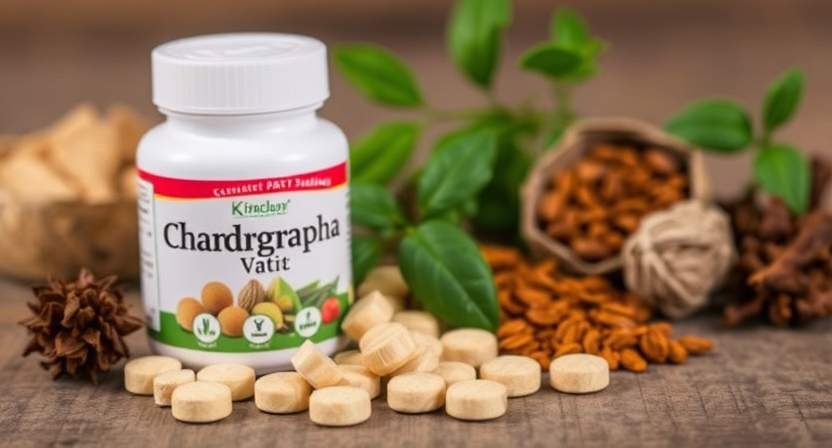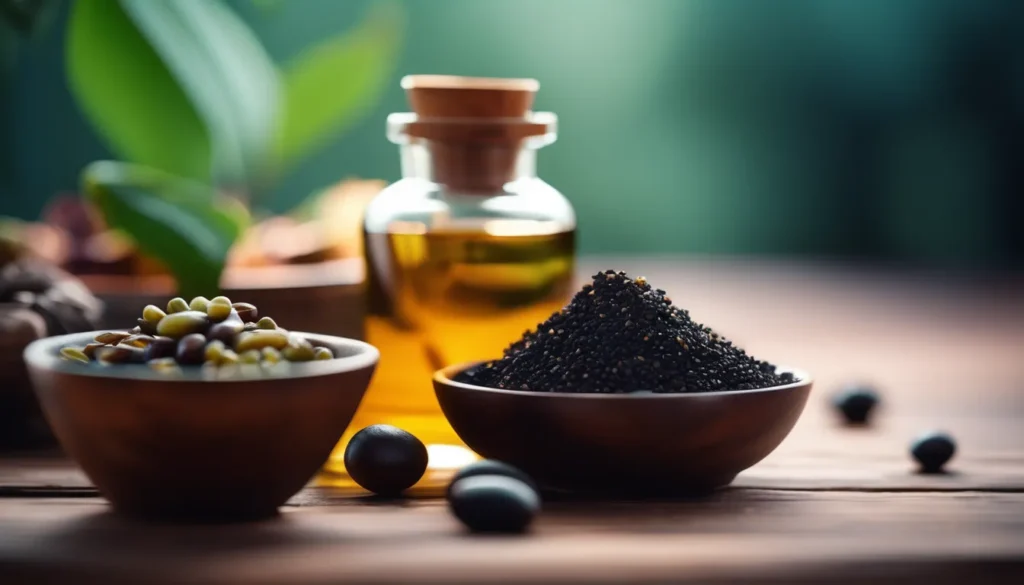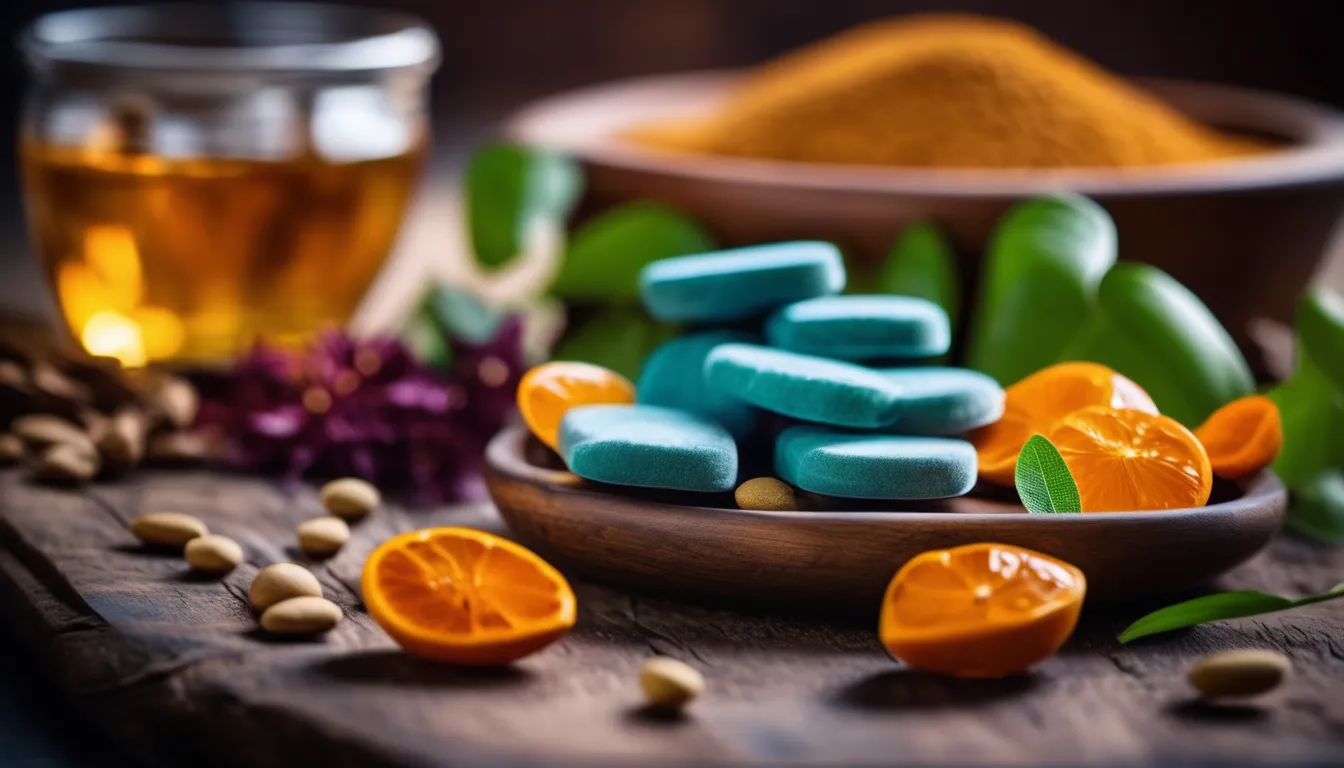
Chandraprabha Vati is a revered polyherbal Ayurvedic formulation known for its potent therapeutic properties. It is a traditional medicine widely used for a multitude of health issues. Let’s explore its preparation, therapeutic benefits, and other essential details.
Table of Contents
What is Chandraprabha Vati?
Chandraprabha Vati is an ancient Ayurvedic formulation composed of a blend of numerous herbs, minerals, and other natural ingredients. The term “Chandraprabha” refers to “the glow of the moon,” suggesting its ability to bring radiance and well-being to the body. It has a wide range of applications in Ayurveda and is commonly used to support urinary health, reproductive health, and overall wellness. It comes in tablet form.

Preparation of Chandraprabha Vati
The preparation of Chandraprabha Vati is a complex, multi-step process that requires expertise in Ayurvedic formulations. It involves the precise measurement, cleaning, and processing of each ingredient. Here is a general overview of the process:
- Ingredient Selection: A specific list of herbal ingredients such as Shilajit, Guggul, Haritaki, Amla, and others are selected according to Ayurvedic texts. These ingredients are chosen for their individual therapeutic properties and their combined synergistic effects.
- Purification and Processing: The raw herbal ingredients are purified and processed using traditional methods. This includes specific cleansing processes, drying, grinding and extraction to ensure their purity and therapeutic efficacy.
- Powder Preparation: Once the ingredients are processed, they are finely powdered. The powdering is done to achieve a uniform particle size to ensure consistent mixing and bioavailability of the ingredients.
- Mixing & Binding: The powdered herbs and minerals are then mixed in precise proportions. Binding agents like guggul or gum acacia are used to hold the mixture together.
- Tablet Formation: The mixture is then pressed into small, uniform tablets. The tablets are dried and coated to ensure their stability and shelf life.
- Quality Checks: Once prepared, the tablets go through strict quality control checks to ensure they meet Ayurvedic standards for purity, potency, and efficacy.
Therapeutic Benefits of the Ingredients:
Chandraprabha Vati is known for its therapeutic efficacy due to the synergistic action of its multiple ingredients. Some key ingredients and their therapeutic benefits include:
- Shilajit: A mineral-rich substance, known for its adaptogenic, rejuvenating, and energy-enhancing properties.
- Guggul: A resin known for its anti-inflammatory, antioxidant, and lipid-lowering effects. It supports joint health and detoxification.
- Haritaki: A potent rejuvenative herb with laxative and detoxifying properties; known to support digestive health.
- Amla (Amalaki): A rich source of Vitamin C and a powerful antioxidant; known for immune support and anti-aging properties.
- Guduchi: An adaptogen and immunomodulator known for its anti-inflammatory and anti-pyretic properties.
- Musta: An herb known for its digestive and anti-diarrheal properties.
- Turmeric: Known for its potent anti-inflammatory and antioxidant properties, supporting overall health.
- Chitrak: Known for stimulating digestive fire and supporting metabolism.
- Ginger and Black Pepper: Known for digestive support, anti-inflammatory, and bioavailability of other nutrients.
- Other Herbs: The formulation also includes various other herbs that offer synergistic benefits for urinary tract health, metabolic function, and overall well-being.
- Mineral salts: Contains a variety of minerals that work in tandem with the herbs to provide enhanced therapeutic benefits.

Top 15 Benefits of Chandraprabha Vati
| # | Benefit | Description |
| 1 | Supports Urinary Health | Helps in managing urinary tract infections, kidney stones, and other urinary issues, and promotes healthy urinary function. |
| 2 | Enhances Reproductive Health (Men) | Improves sperm count, libido, and erectile function, and promotes overall male reproductive health. |
| 3 | Enhances Reproductive Health (Women) | Regulates menstrual cycles, reduces discomfort during menstruation, supports fertility, and improves overall female reproductive health. |
| 4 | Manages Diabetes | Helps in regulating blood sugar levels and reduces the complications associated with diabetes. |
| 5 | Reduces Joint Pain & Inflammation | Alleviates pain, swelling, and stiffness associated with arthritis, and promotes joint flexibility. |
| 6 | Improves Digestion | Enhances digestion, reduces gas, bloating, and constipation, and promotes healthy gut function. |
| 7 | Boosts Immunity | Strengthens the immune system and enhances the body’s ability to fight off infections and diseases. |
| 8 | Promotes Detoxification | Supports liver function, helps in eliminating toxins, and aids in purifying the blood. |
| 9 | Enhances Energy & Vitality | Combats fatigue, reduces weakness, enhances energy levels, and promotes overall strength and vigor. |
| 10 | Supports Metabolic Health | Improves metabolism, aids in proper nutrient absorption, and helps manage metabolic disorders. |
| 11 | Balances Doshas | Helps in balancing the three doshas (Vata, Pitta, and Kapha), promoting harmony and overall well-being. |
| 12 | Antioxidant Support | Provides potent antioxidant protection, preventing cell damage caused by free radicals, and reduces risk of chronic diseases. |
| 13 | Promotes Skin Health | Helps in reducing skin inflammation, improves skin tone, and promotes skin repair, enhancing overall skin health. |
| 14 | Supports Kidney Function | Improves kidney function, helps in removing toxins, and promotes overall kidney health. |
| 15 | Supports Prostate Health | Aids in managing prostate related issues and promotes overall prostate health. |
Chemical Components of Key Ingredients
The following table provides a generalized overview of the primary chemical components found in the major ingredients of Chandraprabha Vati:
| Ingredient | Key Chemical Components | Benefits Related to Components |
| Shilajit | Fulvic acid, humic acid, dibenzo-α-pyrones, minerals (including iron, calcium, magnesium), amino acids. | Adaptogenic, antioxidant, energy-enhancing, anti-inflammatory, and supports nutrient absorption. |
| Guggul | Guggulsterones (Z- and E-), myrrhanol, guggulsterols, essential oils, lignans. | Anti-inflammatory, lipid-lowering, antioxidant, detoxifying, and supports joint health. |
| Haritaki | Tannins (chebulinic acid, gallic acid), triterpenoids, flavonoids, anthraquinones, sterols, polyphenols. | Laxative, digestive, antioxidant, anti-inflammatory, rejuvenative, and supports detoxification. |
| Amla (Amalaki) | Ascorbic acid (Vitamin C), tannins (gallic acid, ellagic acid), flavonoids, phenols, pectin. | Potent antioxidant, rich in Vitamin C, boosts immunity, anti-inflammatory, supports healthy hair and skin. |
| Guduchi | Alkaloids (berberine, tinosporine), diterpenoid lactones (tinosporide, tinosporol), glycosides, polysaccharides. | Immunomodulatory, adaptogenic, anti-inflammatory, anti-pyretic, helps in managing fevers, and supports detoxification. |
| Musta | Sesquiterpenes (cyperone, sesquiterpenoid alcohols), flavonoids, essential oils. | Digestive, anti-diarrheal, anti-inflammatory, antimicrobial, and carminative, promotes digestion and reduces gas. |
| Turmeric | Curcuminoids (curcumin, demethoxycurcumin, bisdemethoxycurcumin), essential oils, volatile oils. | Potent anti-inflammatory, antioxidant, supports joint health, boosts immune function, and promotes liver health. |
| Chitrak | Plumbagin, naphthoquinones, flavonoids, alkaloids. | Digestive stimulant, improves metabolism, anti-inflammatory, anti-microbial and supports liver function. |
| Ginger | Gingerols, shogaols, zingerone, essential oils. | Anti-inflammatory, digestive, antioxidant, carminative, and helps in reducing nausea. |
| Black Pepper | Piperine, alkaloids, essential oils. | Enhances the bioavailability of other nutrients, anti-inflammatory, digestive stimulant, antioxidant, and helps in absorption. |
Note: The composition and amounts of these chemical components can vary based on factors such as growing conditions, geographical location, and processing methods.
Ayurvedic Perspective:
In Ayurveda, Chandraprabha Vati is considered a multi-faceted remedy that works on multiple systems simultaneously, helping to restore balance and promote overall wellness. Its synergistic blend of ingredients is designed to target the root cause of disease.
Therapeutic Dosage:
The standard therapeutic dosage of Chandraprabha Vati is typically:
- Adults: 1 to 2 tablets, twice or thrice daily.
- With Warm Water: It is often taken with warm water to enhance its absorption and therapeutic effects.
- Consultation: The exact dosage may vary depending on individual health conditions, age, and the advice of an Ayurvedic practitioner. It’s always recommended to seek guidance from an experienced practitioner.
Adverse Effects of Chandraprabha Vati:
While Chandraprabha Vati is generally safe, some individuals may experience mild adverse effects, especially with higher dosages or prolonged use. These may include:
- Digestive Issues:
- Mild stomach upset, indigestion, or changes in bowel movements.
- Skin Rashes:
- Rare instances of allergic skin reactions such as mild rashes or itching.
- Increased Urination:
- May cause an increase in frequency of urination, especially in individuals sensitive to diuretics.
When to Avoid:
- Pregnancy and Breastfeeding: Its use is not recommended during pregnancy and breastfeeding as the effects are not well established.
- Children: It is best to avoid giving it to young children.
- Existing Medication: Individuals with existing health conditions or who are on any medications, need to be careful as they may interact. Consulting your physician is essential before starting the medication.
- Allergies: If you are allergic to any of the ingredients, avoid using it.
Precautions:
- Always purchase it from a certified Ayurvedic store or herbal retailer.
- Adhere to the dosage guidelines specified by your Ayurvedic practitioner or doctor.
- Discontinue use if any side effects are experienced and seek medical attention.

Conclusion
Chandraprabha Vati is a powerful polyherbal Ayurvedic formulation that offers a wide range of therapeutic benefits for urinary, reproductive, metabolic, and overall health. Its unique combination of herbs, minerals, and natural ingredients works synergistically to promote balance, strength, and well-being. While generally considered safe.
it’s essential to be aware of potential side effects and take it under the guidance of a qualified Ayurvedic practitioner. By understanding its preparation, benefits, and potential contraindications, one can effectively integrate Chandraprabha Vati into a holistic approach to health.
I once spoke to a patient named Suresh who used Chandraprabha Vati for his kidney issues. He said that after taking it regularly for a few months, along with dietary changes, he noticed a significant improvement in his urinary flow and overall health. “It felt like my kidneys were working much better,” he said, “and it helped me get rid of some nagging discomfort.”
Have you ever explored using Ayurvedic formulations like Chandraprabha Vati? What are your experiences with herbal remedies, and do you have any concerns about using them? Let us know in the comments below!
FAQs about Chandraprabha Vati
- What is Chandraprabha tablet used for?
- Chandraprabha Vati is a polyherbal Ayurvedic formulation primarily used for supporting urinary health, reproductive health (both male and female), managing diabetes, reducing joint pain, improving digestion, and enhancing overall energy and vitality.
- चंद्रप्रभा टेबलेट किसके लिए प्रयोग की जाती है? (What is Chandraprabha tablet used for?)
- चंद्रप्रभा टेबलेट एक बहु-औषधीय आयुर्वेदिक फ़ॉर्मूलेशन है, जो मुख्य रूप से मूत्र स्वास्थ्य, प्रजनन स्वास्थ्य (पुरुष और महिला दोनों), मधुमेह के प्रबंधन, जोड़ों के दर्द को कम करने, पाचन में सुधार करने और समग्र ऊर्जा और जीवन शक्ति को बढ़ाने के लिए उपयोग की जाती है।
- When should we eat Chandraprabha Vati?
- Chandraprabha Vati is typically taken twice or thrice daily with warm water. It’s often recommended to take it after meals for better absorption and to minimize any potential stomach upset. However, your Ayurvedic practitioner may prescribe it differently.
- What are the side effects of Chandraprabha?
- Chandraprabha Vati is generally considered safe, but some people may experience mild side effects, including:
- Digestive discomfort (mild stomach upset or changes in bowel movements)
- Skin rashes (rare allergic reactions)
- Increased urination (due to its diuretic effects)
- It’s important to consult an Ayurvedic practitioner for proper guidance.
- Chandraprabha Vati is generally considered safe, but some people may experience mild side effects, including:
- Which Chandraprabha Vati is best?
- The “best” Chandraprabha Vati depends on individual needs and preferences. Reputable brands that follow traditional manufacturing processes and use high-quality ingredients are usually recommended. Look for brands that adhere to GMP (Good Manufacturing Practices) standards, and consult with your Ayurvedic practitioner.
- Is Chandraprabha Vati good for liver?
- Yes, Chandraprabha Vati contains herbs like Haritaki and Amla that support liver detoxification and overall liver health. It’s beneficial for managing liver-related issues and improving liver function.
- Is Chandraprabha Vati good for constipation?
- Yes, Chandraprabha Vati can help relieve constipation. Ingredients like Haritaki have mild laxative properties that promote regular bowel movements.
- Is Chandraprabha Vati good for blood pressure?
- While not specifically a blood pressure medication, Chandraprabha Vati can help manage blood pressure indirectly by reducing inflammation, improving metabolic function, and reducing stress, all of which can impact blood pressure levels. However, if you have high blood pressure consult with a physician.
- What is the use of ChandraPrabha Vati in prostate?
- Chandraprabha Vati is used to help in prostate related conditions such as Benign Prostatic Hyperplasia (BPH) by reducing inflammation and supporting healthy prostate function.
- Is Chandraprabha Vati anti-inflammatory?
- Yes, many ingredients of Chandraprabha Vati like Guggul, Turmeric, Guduchi and Ginger have known anti-inflammatory properties, which is the reason why it is helpful for joint pain, skin problems and overall health.
- What are the ingredients in Chandraprabha Vati?
- Chandraprabha Vati is composed of a blend of numerous herbs, minerals, and other natural ingredients, some of which include: Shilajit, Guggul, Haritaki, Amla, Guduchi, Musta, Turmeric, Chitrak, Ginger, Black Pepper, and various mineral salts.
- What is the potency of Chandraprabha Vati?
- The potency of Chandraprabha Vati is derived from the specific formulation and the synergistic effects of its various herbal and mineral components. It is a strong formulation designed to address multiple health issues, and the exact potency varies depending on the quality of the ingredients and the manufacturing process.
- Is Chandraprabha Vati good for diabetes?
- Yes, Chandraprabha Vati is helpful in managing diabetes. It contains several ingredients known to help in regulating blood sugar levels, improving insulin sensitivity and reducing complications of diabetes.
- How many doses of Divya Chandraprabha Vati?
- The dosage of Divya Chandraprabha Vati may vary depending on the condition and individual health needs. However, as a general guideline it is advised to take 1-2 tablets, two times a day.
- What is Arogyavardhini vati used for?
- Arogyavardhini Vati is an Ayurvedic formulation primarily used to support liver health, improve digestion, boost immunity, and manage skin disorders. It’s known for its detoxifying and rejuvenating properties.
- What is gokshuradi guggul used for?
- Gokshuradi Guggul is an Ayurvedic formulation mainly used for managing urinary tract disorders, kidney issues, and prostate health. It contains Gokshura, which is known to support kidney function and reduce inflammation.
- Can I take Swasari Vati daily?
- Swasari Vati is an Ayurvedic formulation mainly used for respiratory conditions like coughs, cold, and asthma. It can be used daily for a specific period as per the advice of an Ayurvedic practitioner.
- What is Chandraprabha age?
- “Chandraprabha” refers to the glow of the moon and not an individual. In Ayurvedic context, the “age” of Chandraprabha Vati would refer to how long it’s been used in traditional medicine which is hundreds of years.
- Who is Chandra Prabha?
* “Chandraprabha” is not the name of a person but rather, the name of this Ayurvedic formulation which refers to the “glow of the moon”. - Who is Chandra?
* In Hinduism, Chandra (Moon) is a Vedic deity associated with the moon. Chandra is also known as Soma. - Who is father of Chandra?
- In Hindu mythology, the father of Chandra is Sage Atri.
- Who is the father of Lord Shiva?
- In Hindu mythology, there are varying accounts of Lord Shiva’s origin. Some traditions mention that Lord Shiva is self-born (Swayambhu), while others mention him being born from Brahma or Vishnu, hence there is no specific father of Lord Shiva.
- Which god controls Mangal?
- In Hindu mythology, Mangal (Mars) is controlled by Lord Kartikeya (also known as Murugan or Skanda), the god of war.
- Is Chandra male or female?
- In Hindu mythology, Chandra (the moon god) is considered to be male.
- Which god controls Chandra?
- In Hindu mythology, there is no one god controlling Chandra. However, Chandra is often associated with Lord Vishnu, who is regarded as the preserver of the universe.
- Which God controls the moon?
- The moon is seen as a divine body in Hinduism. The deity associated with the moon is Chandra, and he is considered the god who controls the moon.
- Which God controls Shani?
- In Hindu mythology, Lord Shani (Saturn) is considered a planet deity (Navagraha), and is a god himself. He is a son of Surya and Chaya.
- Which god controls all 9 planets?
- While each planet has its own deity, the supreme deities Vishnu and Shiva, and the goddess Devi (Shakti) are considered the ultimate controllers of all the nine planets.
- Who is moon’s wife?
- In Hindu mythology, the moon god Chandra is married to the 27 daughters of Daksha Prajapati. These 27 daughters are the 27 Nakshatras (lunar constellations). He is primarily associated with Rohini.
- What happens if your moon is weak?
- In Vedic astrology, a weak moon can cause emotional instability, anxiety, mental health issues, and problems related to motherly affection and family harmony.
- What nakshatra was Krishna born in?
- Lord Krishna is believed to have been born in Rohini Nakshatra, which is one of the 27 lunar constellations.
- What is moon’s real name?
- In Hindu mythology, the moon’s most common name is Chandra. He is also known as Soma.
- Who was the father of Sati?
- In Hindu mythology, Sati’s father was Daksha Prajapati, a significant figure in creation mythology.
- Who is the Iron Lady of Assam?
- The “Iron Lady of Assam” is a title given to Priyanka Gandhi Vadra, acknowledging her strong political presence and resilience in the region.
